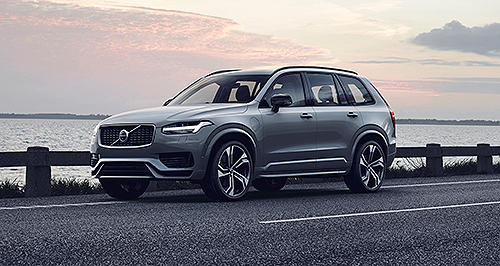Future models - Volvo - XC90Volvo lightly facelifts XC90Mild-hybrid technology, improved active safety systems highlight Volvo XC90 facelift25 Feb 2019 UPDATED: 3.00pm 25/02/2019
VOLVO has lightly facelifted its second-generation XC90 large SUV with improved active safety systems and mild-hybrid powertrains that represent the next step in the Swedish car-maker’s move towards range-wide electrification.
Similar to the set-up used in Formula One racecars, the XC90’s Kinetic Energy Recovery System (KERS) uses a brake-by-wire system to recover kinetic energy under braking and redeploy it under acceleration to reduce the internal-combustion engine’s load.
As a result, the mild-hybrid set-up helps to reduce the XC90’s fuel consumption and emissions by up to 15 per cent in real-world driving, according to Volvo.
KERS will also be rolled out to the XC60 mid-size SUV in the coming months, with existing petrol and diesel engines to adopt the technology across both models.
To reflect this significant change, the brand will tweak its nomenclature, with the XC90’s D5 and T6 to become known as B5 diesel and B6 petrol respectively, while the XC60’s D4 (B4 diesel), T5 (B5 petrol), D5 (B5 diesel) and T6 (B6 petrol) are also set for name changes.
The XC60’s T6 and XC90’s T8 plug-in hybrid powertrains will retain their monikers but be upgraded with new battery packs that can be charged via the aforementioned brake-by-wire system – a combination that increases driving range by about 15 per cent.
The mid-size S60 sedan and V60 wagon and large-size S90 sedan and V90 wagon will also be available in revised T8 form, while the former pair will additionally be offered in enhanced T6 guise.
Furthermore, the XC40 small SUV will soon be available with a pair of plug-in hybrid powertrains in the form of the yet-to-be-detailed T4 and T5.
Meanwhile, several of the XC90’s advanced driver-assist systems have been upgraded, while Oncoming Lane Mitigation – first seen on the XC60 – is now part of its suite.
The XC90 already featured blind-spot monitoring and autonomous emergency braking with pedestrian, cyclist and large-animal detection; but both systems have been revised with collision-avoidance steering support.
Similarly, cross-traffic alert now automatically brakes if another vehicle is about to intersect the XC90’s path.
Externally, the XC90’s refresh is very subtle, with its inverted grille the only noticeable change, aside from new alloy wheel designs and paintwork options.
Inside, a six-seat configuration is now offered optionally alongside new materials, while the touchscreen infotainment system has been enhanced with Android Auto and Spotify support.
Volvo Car Australia has confirmed to GoAuto that the XC90 will enter showrooms "around August/September" this year, while the availability of the mild-hybrid powertrains is yet to be confirmed.
Sales of the XC90 improved last year, with the 1170 examples sold representing a 7.7 per cent increase over the 1086 deliveries made in 2017.
As a result, the XC90 was the seventh best-selling model in the $70,000-plus large-SUV segment, trailing the BMW X5 (2700 units), Range Rover Sport (2258), Lexus RX (2051), Mercedes-Benz GLE (1939), Land Rover Discovery (1833) and Audi Q7 (1622).  Read more2nd of August 2018  Four-seat Volvo XC90 Excellence touches downLuxury-oriented Volvo XC90 Excellence arrives in Australia from $174,200 plus ORCsAll future models Alfa Romeo Alfa Romeo Abarth Abarth Alpine Alpine Alpina Alpina Audi Audi Aston Martin Aston Martin BMW BMW Bentley Bentley Chery Chery Brabham Brabham Chrysler Chrysler Chevrolet Chevrolet Cupra Cupra Citroen Citroen DS DS Dodge Dodge Fiat Fiat Ferrari Ferrari Foton Foton Ford Ford Great Wall Great Wall FPV FPV Haval Haval GWM GWM Honda Honda Holden Holden Hummer Hummer HSV HSV Infiniti Infiniti Hyundai Hyundai Jaguar Jaguar Isuzu Isuzu Kia Kia Jeep Jeep Land Rover Land Rover Lamborghini Lamborghini Lexus Lexus LDV LDV Mahindra Mahindra Lotus Lotus Mazda Mazda Maserati Maserati Mercedes-AMG Mercedes-AMG McLaren McLaren MG MG Mercedes-Benz Mercedes-Benz Mitsubishi Mitsubishi Mini Mini Opel Opel Nissan Nissan Peugeot Peugeot Pagani Pagani Proton Proton Porsche Porsche Renault Renault Ram Ram Rover Rover Rolls-Royce Rolls-Royce Skoda Skoda Saab Saab SsangYong SsangYong Smart Smart Suzuki Suzuki Subaru Subaru Toyota Toyota Tesla Tesla Volvo VolvoXC90 pricing
Motor industry news |
Click to shareVolvo modelsResearch Volvo All future models Alfa Romeo Alfa Romeo Abarth Abarth Alpine Alpine Alpina Alpina Audi Audi Aston Martin Aston Martin BMW BMW Bentley Bentley Chery Chery Brabham Brabham Chrysler Chrysler Chevrolet Chevrolet Cupra Cupra Citroen Citroen DS DS Dodge Dodge Fiat Fiat Ferrari Ferrari Foton Foton Ford Ford Great Wall Great Wall FPV FPV Haval Haval GWM GWM Honda Honda Holden Holden Hummer Hummer HSV HSV Infiniti Infiniti Hyundai Hyundai Jaguar Jaguar Isuzu Isuzu Kia Kia Jeep Jeep Land Rover Land Rover Lamborghini Lamborghini Lexus Lexus LDV LDV Mahindra Mahindra Lotus Lotus Mazda Mazda Maserati Maserati Mercedes-AMG Mercedes-AMG McLaren McLaren MG MG Mercedes-Benz Mercedes-Benz Mitsubishi Mitsubishi Mini Mini Opel Opel Nissan Nissan Peugeot Peugeot Pagani Pagani Proton Proton Porsche Porsche Renault Renault Ram Ram Rover Rover Rolls-Royce Rolls-Royce Skoda Skoda Saab Saab SsangYong SsangYong Smart Smart Suzuki Suzuki Subaru Subaru Toyota Toyota Tesla Tesla Volvo VolvoXC90 pricing
Motor industry news |
















Facebook Twitter Instagram